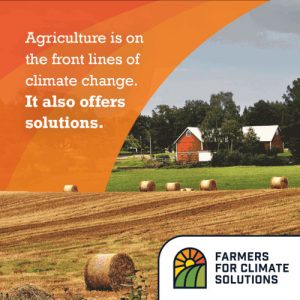As producers realize the importance of regenerative agriculture, especially in its relation to sustainability, innovative implementations are fast emerging. Carbon farming is a practice that allows producers to not only protect the land they farm on, but also produce a better harvest.
 What is Carbon Farming?
What is Carbon Farming?
Current agriculture and forestry practices result in over 25% of the world’s carbon emissions, the majority of which is caused by the misuse of pesticides, fertilizers, and monocropping techniques that deplete the nutrients in the soil and degrade its ability to absorb water and carbon. Carbon farming is a piece of regenerative agriculture that seeks to reverse these adverse actions, by using techniques that draw more CO2 from the air for soil to absorb. These techniques include:
• Agroforestry: Agroforestry is the practice of incorporating the cultivation of trees into one’s agricultural practices. For crop farmers, agroforestry can involve planting under a forest canopy or alternating rows of trees and crops on farmland. For livestock farmers, agroforestry involves housing animals on tree-planted land, in which the trees provide shelter for livestock, reducing their stress during inclement weather.
• Plant covering crops: Cover crops are plants that are not primarily grown for harvest or consumption, but are grown to increase biodiversity in the land they cover. The roots from cover crops feed fungi, earthworms, bugs, and other soil organisms, which increases carbon levels over time. Popular cover crops include oats, alfalfa, clover, buckwheat, and other various types of grasses and legumes.
• No-till farming: No-till farming is a farming technique that removes soil agitation from the growing process. Soil agitation is typically used to break up the hard crust on the soil surface and allow water, air, and nutrients to better penetrate deeper into the soil. However, because tilling fractures the soil, it leads to increased surface runoff rates, erosion, and poor water absorption due to clogged soil pores. No-till farming can be achieved through sod seeding or direct seeding, in which seeds are placed directly onto the soil surface.
The implementation of carbon farming techniques results in farming that is able to have higher production and less pollution. Besides lowering the carbon footprint, it results in soil that is more nutrient-dense, and resistant to erosion and drought, which enables it to produce a better crop.
Carbon Farming in Canada
Within Canada, farming accounts for 10% of carbon emissions. In April of 2021, the Canadian government committed $270 million in its April 2021 federal budget to support regenerative agriculture and climate smart solutions, as part of their Agriculture Climate Solutions program. Specifically, $2.6 million was pledged to the Canadian Forage and Grassland Association to support the development of a Canadian grassland carbon offset system using alfalfa, a key forage crop producers can rely on to capture carbon.
 How to Get Involved
How to Get Involved
If you are a small-scale farmer within Canada and want to implement carbon farming techniques, there are various resources to take advantage of. Farmers for Climate Solutions is a network of Canadian Farmers working to advance agricultural policies that will help Canadian farmers adapt their practices to combat climate change. They have a vast network within which they have created a dialogue on the impact of climate change, solutions farmers can utilize, and policy recommendations. Government grants are also available to help farmers adopt regenerative farming practices, including carbon farming. The Agriculture Climate Solutions program On-Farm Climate Action Fund will provide $200 million from 2021-2024 for farmers to adopt beneficial farming practices including nitrogen management, cover cropping, and rotational grazing practices. The fund is currency recruiting delivery partners who will redistribute the funds directly to farmers, starting in 2022. Click here to learn more about the On-Farm Climate Action Fund.
Sources
https://www.canada.ca/en/agriculture-agri-food/news/2021/07/government-of-canada-invests-26-million-to-improve-alfalfa-growth-and-develop-a-grassland-carbon-offset-system.html
https://www.greenqueen.com.hk/carbon-farming-explainer/?utm_source=Green+Queen+HK+Blog&utm_campaign=425311e6ee-&utm_medium=email&utm_term=0_4c52da5293-425311e6ee-128196064&ct=t()
https://www.cbc.ca/news/canada/agriculture-emissions-reduction-strategy-1.5993201

